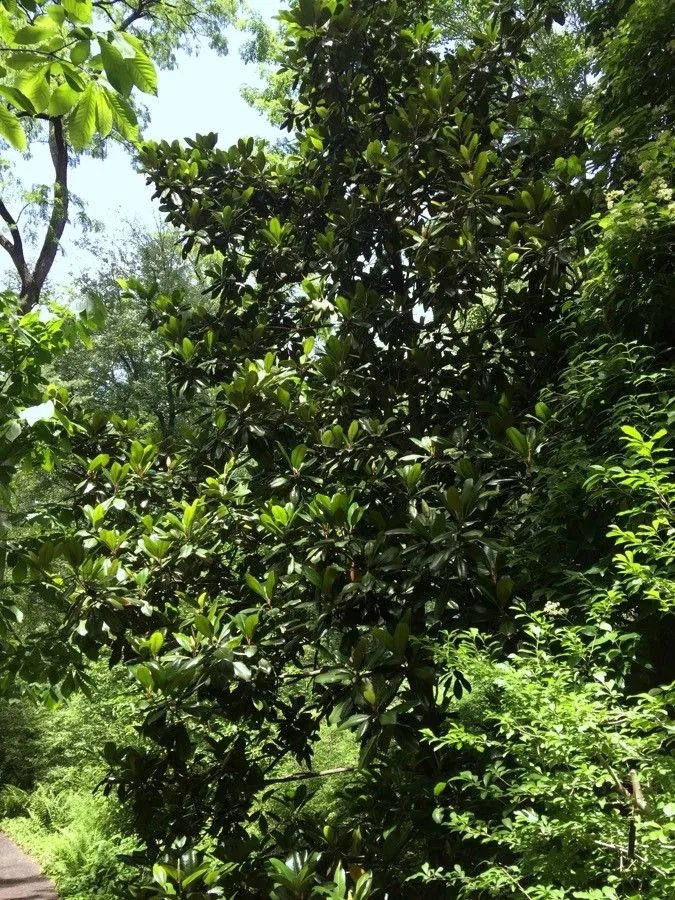
Author: L.
Bibliography: Sp. Pl.: 392 (1753)
Year: 1753
Status: accepted
Rank: species
Genus: Rhododendron
Vegetable: False
Observations: E. U.S.A.
The Great Rhododendron, known scientifically as Rhododendron maximum, is a species that brings both beauty and ecological value to the landscape of the Eastern United States. This magnificent plant is a member of the Ericaceae family, and its history in the botanical world dates back to its formal description in 1753 by the famed botanist Carl Linnaeus, as recorded in the extensive work “Species Plantarum.”
Rhododendron maximum is praised for its lush, evergreen leaves that can add a touch of year-round vibrancy to forests and gardens alike. The leaves are typically leathery and have a pronounced dark green color on the upper side, with a paler tone underneath. These large leaves provide a stark contrast to the clusters of showy blossoms that bloom during the plant’s flowering season.
The Great Rhododendron’s flowers are nothing short of spectacular, often appearing in shades of white, pink, or even purplish hues. These flowers are arranged in dense trusses and can add a pop of color to the undergrowth where they commonly thrive. Each bloom is bell-shaped and adorned with subtle spots of color, making them a favorite among bees, butterflies, and other pollinators.
In the wild, Rhododendron maximum typically inhabits the moist, shaded regions of deciduous forests, often flourishing along streams and in ravines where it benefits from the rich, acidic soils. The plant’s growth habit can vary from a dense, low shrub to a tall, sprawling specimen reaching heights of up to 15 feet, depending on the conditions and geographic location.
Besides its ornamental appeal, the Great Rhododendron plays a vital role in its native ecosystem. Its dense foliage provides shelter for various wildlife, while the nectar-rich flowers offer an important food source for pollinators. Moreover, its presence can help maintain soil stability and prevent erosion, particularly in its natural, forested habitats.
In cultivation, Rhododendron maximum requires specific conditions to replicate its natural environment. Gardeners and landscapers aiming to cultivate this majestic plant should ensure it is planted in well-draining, acidic soil, ideally in a location that mimics the dappled sunlight and cool, moist conditions of its native haunts. Regular watering and mulching can help maintain the necessary soil moisture and temperature, promoting healthy growth and abundant flowering.
Whether appreciated in its wild habitat or cultivated in gardens and landscapes, the Great Rhododendron stands as a testament to the enduring beauty and ecological importance of native flora in the Eastern United States. Its lush greenery and vibrant blossoms continue to captivate all who encounter this remarkable plant.
Eng: great laurel, great rhododendron, great-laurel, rose bay, rosebay, rosebay rhododendron, american rhododendron, big rhododendron
Fra: rhododendron, rhododendron géant, rosage élevé
Swe: sommarrododendron
En: Great rhododendron, Great-laurel, Rose bay, Great laurel, Rosebay, Rosebay rhododendron, American Rhododendron, Big Rhododendron, Late Rhododendron, Summer Rhododendron
Fi: Appalakkienalppiruusu
Fr: Rhododendron, Rhododendron géant, Rosage élevé
De: Riesenrhododendron
Pl: Różanecznik olbrzymi
Ru: Рододендрон крупнейший
Sv: Sommarrododendron
Taken Apr 28, 2021 by Rico (cc-by-sa)
Taken Jan 11, 2022 by Annemarie Ahrens-Stehle (cc-by-sa)
Taken Jan 22, 2022 by Annemarie Ahrens-Stehle (cc-by-sa)
Taken Dec 14, 2020 by Jacques Zuber (cc-by-sa)
Taken Dec 30, 2021 by Tristan Jaton-Maria (cc-by-sa)
Taken Nov 22, 2021 by William Coville (cc-by-sa)
Taken Jun 2, 2021 by Dan d’Auge (cc-by-sa)
Taken Jan 28, 2022 by Kai Best (cc-by-sa)
Taken Mar 3, 2022 by Cyril Sneer (cc-by-sa)
Taken Dec 30, 2021 by Tristan Jaton-Maria (cc-by-sa)
Taken Jan 15, 2020 by Diego Alex (cc-by-sa)
Taken Jun 4, 2022 by Tristan Jaton-Maria (cc-by-sa)
Taken Jan 15, 2020 by Diego Alex (cc-by-sa)
Taken Dec 14, 2020 by Jacques Zuber (cc-by-sa)
Taken Dec 30, 2021 by Tristan Jaton-Maria (cc-by-sa)
Taken Jan 28, 2022 by Kai Best (cc-by-sa)
Taken Oct 18, 2019 by Brunello Demarchi (cc-by-sa)
Taken Dec 14, 2020 by Jacques Zuber (cc-by-sa)
Taken Oct 5, 2019 by Dieter Wagner (cc-by-sa)
Taken Dec 30, 2021 by Tristan Jaton-Maria (cc-by-sa)
Taken Nov 6, 2021 by Rane (cc-by-sa)
Taken Mar 26, 2022 by Rvt 063 (cc-by-sa)
Taken Jul 6, 2021 by Jim Hynd (cc-by-sa)
Taken Aug 17, 2021 by meme38 (cc-by-sa)
Taken Oct 5, 2019 by Dieter Wagner (cc-by-sa)
Taken Aug 9, 2021 by pernambucojurema (cc-by-sa)
Taken Jan 13, 2022 by William Coville (cc-by-sa)
Taken Jun 18, 2020 by matthieu cardin (cc-by-sa)
Taken Nov 13, 2021 by Jörg D (cc-by-sa)
Taken Jun 4, 2022 by William Coville (cc-by-sa)
© copyright of the Board of Trustees of the Royal Botanic Gardens, Kew.
© copyright of the Board of Trustees of the Royal Botanic Gardens, Kew.
Growth form>: Multiple Stem
Growth habit>: Tree, Shrub
Growth rate>: Slow
Ph maximum: 5.5
Ph minimum: 4.0
Family: Myrtaceae Author: (F.Muell.) K.D.Hill & L.A.S.Johnson Bibliography: Telopea 6: 402 (1995) Year: 1995 Status:…
Family: Rubiaceae Author: Pierre ex A.Froehner Bibliography: Notizbl. Bot. Gart. Berlin-Dahlem 1: 237 (1897) Year:…
Family: Sapindaceae Author: Koidz. Bibliography: J. Coll. Sci. Imp. Univ. Tokyo 32(1): 38 (1911) Year:…
Family: Asteraceae Author: A.Gray Bibliography: Pacif. Railr. Rep.: 107 (1857) Year: 1857 Status: accepted Rank:…
Family: Fabaceae Author: Medik. Bibliography: Vorles. Churpfälz. Phys.-Ökon. Ges. 2: 398 (1787) Year: 1787 Status:…
Family: Aspleniaceae Author: (Cav.) Alston Bibliography: Bull. Misc. Inform. Kew 1932: 309 (1932) Year: 1932…